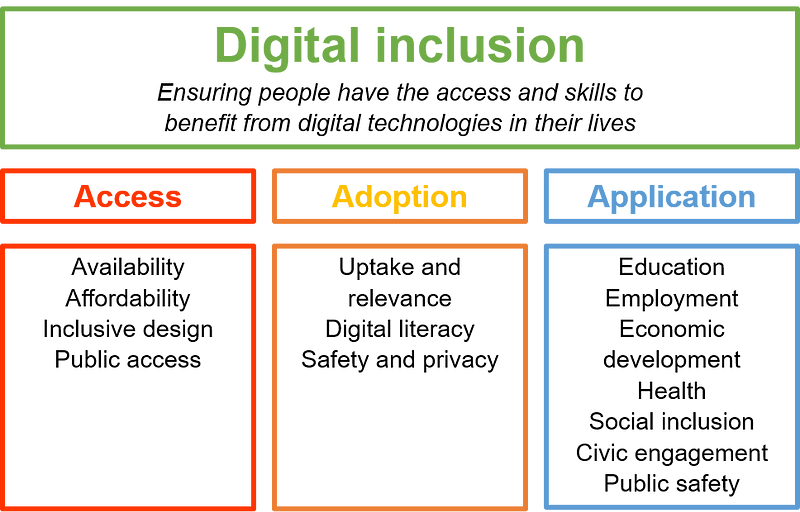
The internet is transforming the world, but not for everybody
The Ontario Digital Inclusion Summit aims to find, understand and fix the gaps that keep some citizens from accessing and benefiting from the digital world.

Ontario Digital Inclusion Summit
Making Technology Work for Everyone
Feb. 9–10, 2018
Toronto, Ontario
Contact: inclusion@ppforum.ca
We’d like to bring people together around the idea of digital inclusion.
For decades people have hoped that the internet will transform society, the economy, and even the fundamentals of our democracy.
While someone with arthritis and short-term memory issues struggles to remember and type passwords to online accounts.
While another buses an hour to public computers in a job centre because applying is next to impossible on their only device, a phone.
While yet another misunderstands the legalistic language on a government website and thinks they’re ineligible for benefits.
Who is the internet transforming our world for?
The way we use the internet is changing. We’re coming to a point of maturity where we’re internalizing that the internet has distinct patterns and cultures, some of which are new and transformational. As we learn this, in the name of designing better digital interactions and communities, we learn in lockstep the limits of the digital world. What cultures aren’t represented. Who isn’t participating.
“Digital inclusion” refers to a goal, a process and a future state. Today, we have patterns of inequitable digital access, affordability, skills, and cultures. As our society increasingly moves online, this means that some citizens have less opportunity to participate in the economy, form social networks or access government services. The benefits and drawbacks are being felt disproportionately in different parts of society.
There’s also a research and policy gap. It’s not merely about knowing that digital divides are real, but understanding at the ground level how they affect particular groups, communities, regions and individuals so that governments and other stakeholders can adapt. In a world where people debate big and small government, it’s about deciding, together, what our collective responsibility is to each other — and how digital provides both new opportunities and challenges in upholding that responsibility.
In February 2018, we’re hosting the Ontario Digital Inclusion Summit in Toronto, Ontario. We want this event to serve as a community hub to share research and insights, create opportunities for future multi-sector collaboration, and start to develop a shared understanding about the issue and possible paths forward.
The goal is to bring 200 people together from government, the private sector, academia, and the not-for profit world. The Summit’s organization will reflect its goals, with an emphasis on inclusivity, including travel and participation bursaries and targeted outreach. We’d love to hear what would work for you to make that happen.
We want digital inclusion to be a collective concept that gets improved over time, so let us know where you think the conversation needs to go. As a starting point, however, we’re looking for ideas and proposals for content and talks at the Summit:
- Academic, NGO, and polling research
- A broad range of perspectives on the digital world, its biases, and how it impacts people
- A sense of what governments, civil society and the private sector are already doing in this space — the good, the bad, the successful, the not
- What we’ve learned from inclusive design and user experience research
- Stories about the barriers and challenges people face as well as the potential and wins
- A conversation about what our collective responsibility to each other should be, mapped to the opportunities and limits of the digital world
Our working definition of digital inclusion (which we want to refine and expand):

benefit from digital technologies in their lives. ACCESS: Availability, Affordability, Inclusive design, Public access. ADOPTION: Uptake and relevance, Digital literacy, Safety and privacy. APPLICATION: Education, Employment, Economic development, Health, Social inclusion, Civic engagement, Public safety
What is digital inclusion?
It’s ensuring that people — especially those in marginalized groups — can benefit from digital technologies in their lives. There are three overarching areas of action: Access, Adoption, and Application. Inclusion requires all three: for instance, if unable to afford access to the Internet, or if interfaces are not designed to accommodate users with screen readers, a learner with disabilities will be unable to benefit from the educational opportunities available via online learning.
What inclusion looks like:
- Availability: High speed Internet access is available to all members of the community.
- Affordability: Access to the Internet and digital technologies is affordable.
- Inclusive design: Digital technologies and services are usable by people with differing levels of digital skills and ability, including people with disabilities.
- Public access: People who cannot afford digital technologies can do so for free in public places.
We’d love to hear from you
- If you’re interested in learning more, sharing insight at the Summit, sponsoring, partnering or volunteering, please let us know: inclusion@ppforum.ca.
- You can also visit and share the Summit website and sign up for (infrequent, thoughtful) updates.
Meghan Hellstern, Kent Aitken and Claude Lauziere
On behalf of the Summit team and our partners in the Government of Ontario and the Public Policy Forum





